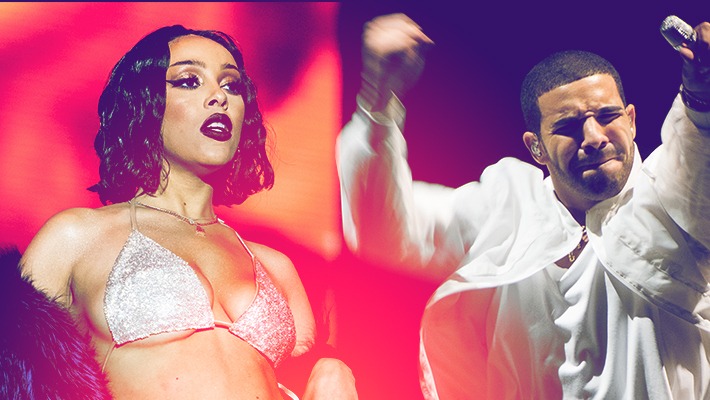Given what we’ve witnessed in the last few years, It’s no secret that TikTok dance crazes have major pull in making musical hits. Doja Cat’s “Say So” gained significant ground as the background music of a popular routine before hitting the top slot on Billboard Hot 100 chart in 2020. The popular app also has an uncanny ability to bring songs back from mild obscurity thanks to highly-emulated dance videos, like Mariah Carey’s “Obsessed” and Fergie’s “London Bridge.”
TikTok’s choreography is clearly hip-hop inspired, which isn’t surprising given the high-energy nature of the songs used. But although dance is essentially one of the core elements of the genre, it’s more often than not lambasted as “corny,” lyrically evident by Terror Squad’s 2004 hit “Lean Back.” (“My n****s don’t dance, they just pull up their pants,” Fat Joe quips in the chorus.) Despite the naysayers, dance floor-ready songs have always been essential for success. The popularity of these dance crazes, specifically through social media’s lens, signals a generation-led shift in the market.
While the internet is not the end-all and be-all tool for cultural domination (especially given the popularity of fad dances like the Running Man or the PeeWee Herman since before the web’s inception), it’s surely the most effective way to create virality. TikTok’s dance-centered popularity has altered the course of the music industry, but it is in no way a new phenomenon. During the internet’s first dance craze boom in the mid-2000s, then-unknown hip-hop artists similarly used social media to set the internet ablaze, recognizing that by utilizing these growing sites and the contagiousness of rhythm, they would be able to get their work off the ground. Whether calculated or not, these dances created major cultural moments.
In 2006, the internet, dance, and Atlanta-bred hip-hop subgenre snap worked together to supply fans with easy-to-follow dance moves over a catchy, minimalist beat. Although snap music was called “laughable,” “goofy,” and “cheap-sounding” by The New York Times in 2006, its dance-heavy popularity during the mid-aughts was applauded for helping to reboot the digital singles market. (Nielsen Soundscan reports that in the U.S. alone, 582 million digital singles were sold in 2006, a 65 percent upswing from the previous year).
With MySpace’s supremacy, music-sharing sites like Soundclick, and the rising popularity of YouTube, you’d be hard-pressed to find someone who didn’t know the dances to snap-heavy tracks like Dem Franchize Boyz’s “Lean Wit It, Rock Wit It” or Yung Joc’s “It’s Goin’ Down.” As a result of this growing trend, artists like Harlem’s Webstar and Young B and Atlanta’s Soulja Boy got in on the fun, creating their own wildly-popular dances, the “Chicken Noodle Soup” and “Crank That (Soulja Boy).” Not only were these iconic moves central to the height of the Digital Age of dance crazes, but the virality of these songs also helped the artists grow. Dem Franchize Boyz and Yung Joc garnered top 10 hits, “Crank that” went No. 1 on Billboard’s Hot 100, and “Chicken Noodle Soup” was re-made in 2020 by BTS’ J-Hope and singer Becky G, proving its cultural and racial transcendence.
As we see with both then and now, the 1-2 punch of the right song and dance combination results in societal and chart supremacy, and companies have always taken notice. In 2008, The Wall Street Journal reported that major labels like Warner Music Group and Sony BMG “[were] scouring the country to find the next big set of steps,” as “the dance surge is also changing the way labels market their product” — perhaps at a detriment to the natural essence of dance trends. Does the premeditated approach taken by artists and labels in making the next big hit diminish dance fads’ originally organic nature?
The difference between the virality of K-Camp’s 2019 song “Lottery (Renegade)” and Drake’s No. 1 hit “Toosie Slide” should be obvious — one garnered natural popularity due to a rapid-speed dance challenge, while the other was self-orchestrated to sell. The “Renegade” dance, made by Georgia teen Jalaiah Harmon, created something far larger than the song itself; it was done by regular people and major celebrities alike, and Harmon performed it at the 2020 NBA All-Star Game. While ingenious (though not groundbreaking), the “leak” of the “Toosie Slide” routine before its actual release manufactured something that can’t always be forced: cultural moments. While Drake’s song and dance succeeded commercially, most crazes truly work best when they become inescapable staples of popular culture without much effort, like Drake’s own previous dance-driven effort, “In My Feelings,” which was driven by the inescapable Shiggy Challenge in 2018.
This is not to say that artists shouldn’t try their hand at creating dance challenges for their songs, however, forcing virality has seemingly adverse effects on the song’s overall staying power. A manufactured approach worked a bit for Unk with “2 Step” in 2007 and Megan Thee Stallion with “Body” in 2020, but it’s apparent that those song and dance combos did not match the commercial or chart success of their previous hits, “Walk It Out” and “Savage,” likely because their popularity didn’t come naturally.
The music industry is a business that thrives on trends — we know that. However, when it comes to dance crazes, in particular, it may be the best bet for artists and labels to allow these trends to take over organically instead of through calculation. The difference between a passing fad and a true cultural moment is largely determined by fans themselves, whether through the moment’s show-stopping relevancy or the evocation of a feeling largely associated with a specific time in their lives. While the age of COVID-19 seems like the prime time to drop a potentially chart-topping, dance-heavy, internet-shaking tune, releasing something for sake of profiting off of it exploits the trend instead of enhancing what makes it work in the first place.
Some artists covered here are Warner Music artists. Uproxx is an independent subsidiary of Warner Music Group.

